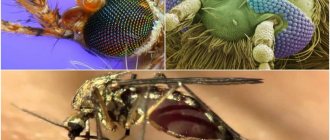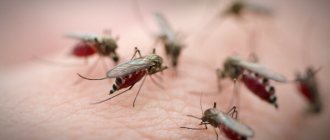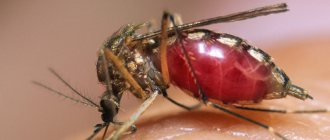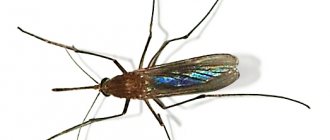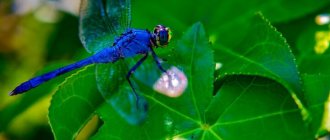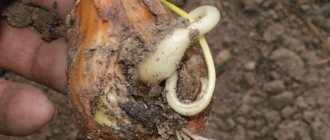Features and habitat
These insects have excellent camouflage abilities. Their shades take on the color of the plants they parasitize. Green aphids on apples, grapes, and houseplants; black aphids are observed on cherries and cherries; red aphids eat currants and gooseberries; a yellow-colored insect with a green tint parasitizes cucumbers and melons.
In most cases, aphids have an oval shape. Sometimes these insects are found in the form of a drop, a ball, an egg or an ellipse. The size of the aphid is tiny, but it can still be seen with the naked eye. Its length reaches up to 0.7 mm. In rare cases, you can find giants among them, with a size of about 7 mm.
This insect is one of those that feed on plant foods. They are equipped with a special proboscis that pierces the plant tissue and draws out all the juices from it. They can reproduce amazingly quickly, this is one of the most important characteristics of aphids. Insects come with or without porches.
An interesting cycle occurs in nature, which cannot but be paid attention to. Aphids obtain protein compounds and amino acids that are important for development and life through plant sap. During the processing of these useful substances, a suspension of sticky consistency is released, which is a favorite delicacy of flies and ants.
Scientists have noticed strange facts of cooperation between aphids and ants, who are trying in every possible way to protect their nurses from possible troubles. Moreover, ants carry aphids from one plant to another, and even hide their females in their homes from winter cold and frost. After such an observation, you have to fight not only with aphids, but also with their “guardians”.
The aphid's body is not protected by a shell, like many insects; it is soft and exposed to external influences - the aphid can easily be crushed. The insect has long limbs, but this does not mean that the aphid can move quickly. She does it slowly.
Wingless insects differ visually from winged ones. The former have a longer and thicker proboscis. The winged aphid has two pairs of wings, with the help of which it easily moves in space.
Winged aphids have a slightly different rhythm of life from wingless aphids. In autumn, eggs of a winged, fertilized female are laid. Eggs are not laid in all places.
Insects give preference to wild radish, rapeseed, and cabbage stalks. The eggs remain on these plants throughout the winter. With the arrival of spring, they turn into larvae, which develop and survive due to the cellular sap of green spaces.
Then they molt, after which the aphids reproduce. By the way, they succeed without any gender differences. As a result, a large number of insect larvae are born. Scientists who observed this process were horrified. Within one month, one female can give birth to about 10,000 insects.
Wingless aphids lead an almost sedentary lifestyle. From birth to their last days they are in one place. With the help of their proboscis, aphids feed on plant sap, receive all the components important for life and develop perfectly.
If you don’t fight it and don’t try to destroy it, then it will continue to parasitize, multiply and cause harm to the plant world. Moreover, the presence of males is absolutely not necessary.
Around mid-summer, winged representatives periodically begin to appear in the crowd of wingless females. They, in turn, move to new green areas without any problems and take great pleasure in settling down there.
Winged aphids play an important role in the continuation of their entire lineage. After all, aphids, which are unable to move, may eventually run out of food reserves and die. Migratory aphids immediately form huge colonies of similar creatures in a new place.
The end of summer is significant for these insects in that creatures of different sexes finally appear among them, between which mating occurs. With the arrival of winter frosts, insects die, leaving behind eggs, which, with the arrival of spring, will go through the same life cycle and die in the winter.
How to determine the appearance of aphids on a plant? If green spaces gradually begin to lose their attractive appearance, it is necessary to inspect them.
Typically, wingless aphids are found under plant leaves. The colonies, increased in size, now completely cover all green spaces without any embarrassment or fear. After a short contact with these insects, the leaves dry out and, after curling, die completely.
All fruit trees produce much less yield. Sometimes their fruits fall off before they ripen. Shoots and trunks of plants are bent. In addition, all damaged plants are covered with sweet secretions of aphids, which gardeners call honeydew.
If honey dew is not eaten by ants, the plant becomes infected with sooty fungus. From this it follows that the appearance of a large number of ants in frequent cases indicates that an aphid is parasitizing somewhere nearby, although the fruits of its deeds are not yet visible.
The most suitable climate for these pests is humid and warm. Only under such conditions is mass reproduction of aphids possible. It can be found in many territories, from Europe to Siberia.
Development and body structure
A little about what aphids look like. The total size of an adult is from two to six millimeters, the largest species reach eight. Depending on the variety, the insect’s body is characterized by the outlines of the following shapes:
- oval;
- teardrop-shaped;
- in the form of an ellipse.
The color ranges from black and pink to completely transparent. The body is covered with growths and hairs of varying density and length.
Head
In most species, this part of the body looks like a trapezoid, with small antennae that serve as organs of touch and hearing. The eyes have a complex facet structure that provides high clarity of vision. The color shade of the organs of vision coincides with the general color of the body.
Considering the feeding habits, the main organ of the oral apparatus is the proboscis. Depending on the method of parasitism, in some this organ is long and pointed, in others it is short and blunt. In some species, the length of the proboscis exceeds the body size up to three times.
Abdominal part
Consists of nine segments. The first seven perform a respiratory function, the rest contain tubes that remove vital secretions.
Wings
Insects are divided into wingless species and those with the specified body part. Winged varieties are distinguished by two pairs of teardrop-shaped wings with a transparent structure. When danger or unfavorable conditions for development arise, the colony reproduces winged varieties of insects of different sexes, which allows them to change their habitat and increase the intensity of reproduction.
hairy tail
The last of the abdominal segments is a rudimentary tail covered with small hairs.
Reproduction
Aphids reproduce in two ways:
- in the warm season - live birth, without the participation of males;
- In the fall, the mating season begins - females lay fertilized eggs, which overwinter until the onset of spring warmth.
Differences in the appearance of the insect sexes are not always present. This is mainly manifested in the presence or absence of wings.
Egg
Eggs laid for the winter have a round or elongated shape with oval outlines. Most often they are distinguished by a light color, but there are dark colors or mimic ones, depending on the characteristics of the habitat.
Larva
It resembles an adult, with a similar structure, differs by a longer proboscis and an undeveloped tail.
Lifestyle of aphids
The insect aphid prefers to live in large colonies. Its favorite habitats are on green leaves and young shoots. Ants become companions throughout their lives. This tandem benefits both of them. The aphid is under the reliable protection of the ant, which feeds on its honeydew.
It's interesting to watch their interactions. The ant approaches the aphid and, after gentle tickling, receives a portion of the sweet liquid. This droplet is transmitted along a chain to the ant’s house, where aphids often find refuge in the winter. Aphids have enemies from which the ant tries to carefully protect them. Ladybugs and lacewings can destroy aphid colonies.
Types of aphids
Scientists know more than 4,000 species of aphids, about 1,000 of which live in Europe. Most of them feed without browsing plants. But among them there are those who give preference to one thing.
Leaf gall aphids, for example, love currants. In the shortest possible time, such “love” can cause the plant to die. The distribution of this species is very wide.
You can recognize the insect by its oval body shape, yellow or pale green color and a couple of transparent wings if it is a winged aphid. The size of gall aphids is about 3 mm. After contact with insects, the currant leaves first turn yellow, and then acquire a burgundy tint and swell.
Beet aphids are also oval in shape. But there may be some differences in its color. Aphids can be not only green, but also brown, and even black with a white breast. The entire insect seems to be covered with wax.
This aphid prefers beets, potatoes, legumes, poppy, jasmine, sunflower and viburnum. Transcaucasia, Central Asia, and North America are the main habitats of these pests.
The cucumber (melon) aphid has a somewhat elongated body with a variety of shades of green. The limbs and whiskers of the insect are colored brown. Most often it is found on watermelons, melons, pumpkins, cucumbers, tobacco, peanuts, and beets. Sometimes such aphids can settle on citrus trees and eucalyptus.
Cabbage aphid has oval and wide shapes. Its color matches the color of cabbage leaves, on which the insect can most often be found. In addition, this aphid loves radishes and radishes. Plants die very quickly from a massive accumulation of cabbage aphids.
Grape phylloxera has an oval-shaped body with a yellow or brown tint. Does not like any other plants except grapes. It is found on the African continent, in some places in Asia, in North America and in European territory.
Carrot aphids prefer only carrots and some umbrella plants, which causes them to quickly die. It is small in size, has an oval body and is light green in color.
The green apple aphid is green in color and has an oval-shaped body. It can be distinguished from other species by its red or chestnut head. Apple orchards, pear, cotoneaster, hawthorn, and quince suffer from this insect.
Potato aphids are red in color. The aphid is winged with a green tint, brown limbs and antennae. All garden plants and those grown in a greenhouse and indoors suffer from it.
The peach aphid is round, gray-brown in color, with orange limbs and black spots on the top. Habitat: Crimea. It loves nut and fruit plantings, which it causes incredible harm and exposes to fungal diseases.
Mealy aphids are oval-shaped and cream-colored. It is found on indoor flowers, in greenhouses, on grapes and citrus fruits. Aphid colonies on such plants lead to their death.
House aphids come in white, red, green and black varieties. It feeds on any plants, causing them to initially dry out and then die altogether.
White aphids are well known to lovers of indoor flowers. Her body is transparent in color. The appearance of this pest on one indoor flower threatens all plants in the apartment. White aphids should be dealt with immediately.
How it appears on indoor flowers
Flies through open windows and doors
Aphids pose a threat to both garden and home crops. Parasitic individuals can enter the room if it is located on the lower floors. Females with wings fly low, but strong gusts of wind allow pests to enter the house through an open balcony or windows.
A preventive method is a mosquito net, which serves as a barrier to insects.
Interesting! Even one or two parasites are enough to destroy decorative flowers or trees.
On clothes and shoes
If the measures are followed and the house is completely isolated from insects, you should not let your guard down. Aphids can enter an apartment on a person or a pet. Its larvae are so small that they are invisible on clothes or shoes. In some cases, aphids can only be detected when the plant is already withering.
Together with other plants
Soil that is outdoors may be contaminated with pest larvae. If it is used without treatment for planting house plants, then aphids will easily penetrate into the apartment. And it won't be easy to get rid of it.
To replant flowers, you should give preference to treated soil, which is sold in special stores.
For the safety of indoor plants, it is important to adhere to the following recommendations:
- Close windows in sunny and windy weather. Place flowers deeper into rooms.
- If the plants are located outside, they should be covered with a special material that will not block the sun's rays, but will protect them from insects.
- The mosquito net should have small cells to serve as an obstacle not only to large insects, but also to aphids.
- When it is not possible to buy clean soil, it is important to treat the soil from the street with boiling water. Do this not indoors.
- New flowers are kept for a month in a separate room. Such quarantine will help protect old plants from possible risk.
- Basic methods of struggle
What to do if aphids appear on the leaves?
For many gardeners and amateur flower growers, this is one of the most pressing issues. This is only initially and to people who have not encountered this problem, it may seem that there is nothing complicated about it.
In principle, an ordinary soap solution is destructive for aphid pests. The problem arises because a large number of aphids causes the plant to change its external characteristics.
The insect sucks out all the juices from it, causing its leaves to curl into a tube. It is in such twisted leaves that aphids find refuge. Therefore, it is necessary to fight it even before the leaves bloom on the trees.
It is better to treat them in the spring, as soon as the swelling of the buds is noticeable. When declaring war on aphids, you must not forget about ants and also use drugs against them.
Getting rid of ants is not difficult. This is done using padding polyester, in which the tree trunk is wrapped. The synthetic winterizer must first be treated with a chemical against ants. Currently, there is a large selection of such funds. “Aardeater” is considered to be often used.
Some gardeners try to get rid of aphids mechanically. They remove it with their hands and a stream of water under strong pressure. This is the only way to get rid of pests found on low-growing plants.
You can make sure that in an area with a large number of aphids there are those who can easily deal with them. These include ladybugs, some types of wasps, hoverflies, and lacewings. For many birds, aphids act as a treat. They can be attracted by birdhouses and special bird feeders.
Aphids react negatively to the aromas of some plants. You can sow mint around the area, marigolds and aphids will slowly begin to clear out of this area. This insect does not like the smell of garlic, cilantro, fennel, and basil.
There are many chemicals, the use of which gives positive results in the fight against aphids. Among them, we can highlight such aphid remedies as “Fitoverm”, “Aktofit”, “Jaguar”. Each of these drugs has its own spectrum of action and instructions for use.
Prevention measures
It is easier to prevent any phenomenon than to correct its consequences later. To avoid suffering from aphid infestations, take preventive measures in a timely manner:
- Inspect the leaves of the plants. Pay special attention to the outside.
- Do not use untested soil, it may be contaminated.
- Quarantine new plants. If infected, old flowers will be safe.
- Use insects that control aphids.
- Plant repellent plants, natural protection against pests.
- Do not leave pulled grass on the site; it can serve as breeding ground for aphid larvae.
- Treat the walls of the greenhouse with a disinfectant solution.
To prevent aphid colonies from interfering with the plants in your garden to grow and bear fruit quietly, take timely measures and do not let the situation take its course.
Reproduction and lifespan of aphids
There are aphids that lay eggs. But there are also insects that are called viviparous. Parthenogenesis is inherent in many species of these insect pests. Some of the aphids come into the world with wings and different sexes. Others are the opposite.
A major role in the continuation of the aphid species is played by winged individuals, who do not allow their own kind to die of hunger, but move to new territories in search of food for themselves.
Scientists have noticed that winged aphids often appear if, for example, there are a large number of ladybugs in the area. The whole process is very complicated. But if we briefly try to explain it, then everything happens as follows.
The ladybug finds its prey and eats it. As a result, the aphids produce a specific aromatic substance, which is captured by all aphids in the colony. This causes panic. In such a panic, more aphids with wings are born.
This insect is not long-lived. Aphids can live for several days or months. With the onset of frost, it all dies. Except for the one that was given shelter by the rescue ants.
How to get rid of pests?
Before getting rid of gray aphids with chemicals, it is worth carrying out agrotechnical measures:
- regular destruction of growth at the roots, as well as fatty shoots, which are used by some types of aphids for development and wintering;
- autumn cleaning of branches and trunks from particles of dead bark, where parasite eggs usually hide;
- Sowing umbrella crops that attract migrating insects.
To destroy individuals, early spring spraying with mineral oil preparations or a mixture of kerosene and diesel fuel is used - this technique will prevent the appearance of caterpillars from eggs left for the winter. In addition, it is advisable to treat with insecticides in the period after the emergence of new larvae and before the winged females appear.
During the formation of the first colonies, it is best to treat only the inhabited branches, and in young crops - the tops of the shoots. In addition to insecticides, you can also use infusions of fragrant plants, as well as a solution of soda ash or laundry soap.
The number of individuals can be reduced by entomophages, especially ladybugs - it is recommended to release them onto plants infested with aphids.
